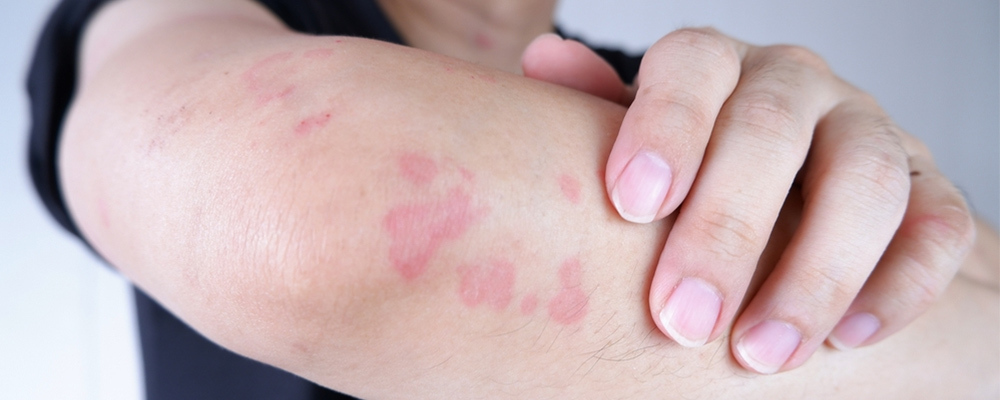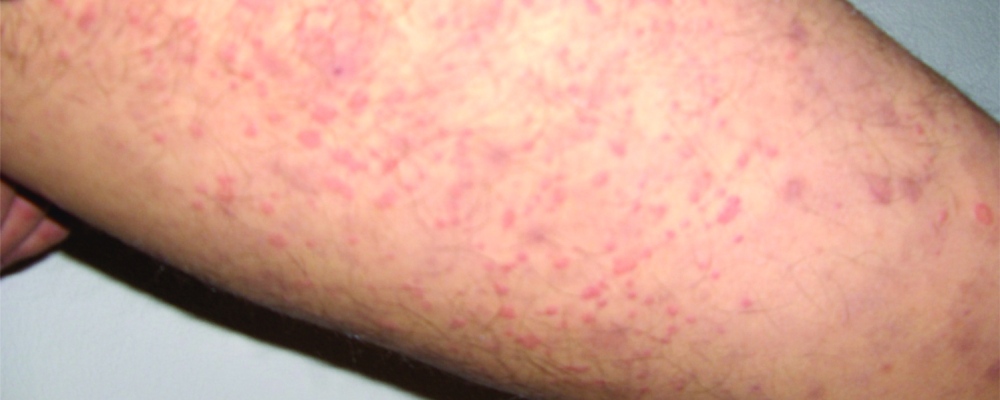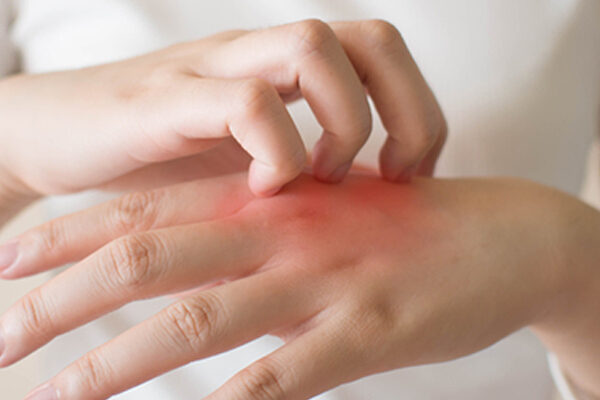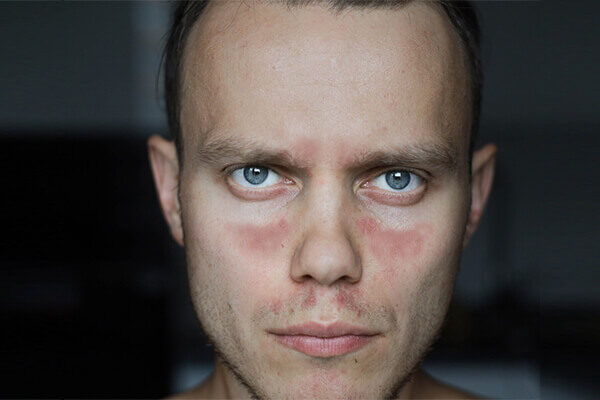Updated on April 19, 2023
Introduction
Urticarial vasculitis is a rare skin condition with raised red patches and hives. These hives can last several weeks or months and can affect both men and women. It is difficult to diagnose and may significantly impact a person’s quality of life. Thus, it is necessary to raise awareness regarding this condition.
In this blog, we will look into the manifestations, causes, symptoms, diagnosis, and types. Additionally, you may want to explore ongoing research and advancement therapies for urticarial vasculitis.
What is Urticarial Vasculitis?
Urticarial vasculitis is a rare form of vasculitis that can cause itching, burning, and discoloration. As the name indicates, this condition is a combination of urticaria (hives) and vasculitis. Vasculitis is characterized by inflammation and swelling that affects the blood vessels and obstructs blood flow throughout the body due to vessel swelling and stretching. Urticaria, on the other hand, is commonly referred to as hives. It is characterized as raised, red, or discolored bumps on the skin.
While primarily affecting the skin, urticarial vasculitis involves blood vessels in various body parts, including joints, heart, kidneys, eyes, and lungs.
Normocomplementemic Urticarial Vasculitis vs Hypocomplementemic Urticarial Vasculitis
Based on the level of complement protein in the blood, this condition can be classified as “Normocomplementemic urticarial vasculitis” and “Hypocomplementemic urticarial vasculitis”:
- Normocomplementemic urticarial vasculitis: In this type, complement protein levels are within range. It is usually not severe and has little systemic (affecting multiple organs) involvement.
- Hypocomplementemic urticarial vasculitis: It is the opposite of normocomplementemic urticarial vasculitis. The complement proteins remain low, and this type is more severe, having multiple systemic involvements affecting the joints, lungs, kidneys, gastrointestinal tract, and eyes.
Urticarial Vasculitis Causes
Inflammation of the blood vessels supplying blood to vital organs. Restriction in blood flow causes damage to the organs. This damage is most prevalent in the skin. There can be many urticarial vasculitis causes. Some include:
- Inflammatory connective disorders (SLE and Sjögren syndrome)
- Immunoglobulin disorders (immunoglobulin A and immunoglobulin M monoclonal gammopathies)
- Leukaemia and internal cancers
- Viral diseases (hepatitis B, hepatitis C, and infectious mononucleosis)
- Drug-induced conditions (ACE inhibitors, penicillin, sulfonamides, fluoxetine, and thiazides)
Other than the above-mentioned accompanying medical conditions, various other factors may influence its development:
- Genetic factors
- Environmental triggers (such as cold temperatures or sunlight)
- Medications (antibiotics and nonsteroidal anti-inflammatory drugs)
However, this condition is idiopathic (there is no known cause) in origin.
Urticarial Vasculitis Symptoms
It manifests as skin patches that may be present for more than 24 hours and leave a bruise-like discoloration as they heal. Some of the most common symptoms are:
-
Skin rash:
A reddish elevation of the skin. Urticarial vasculitis symptoms can start with the eruption of skin lesions (wheals) and hives (urticaria).
-
Pruritis:
Pruritus is an itchy sensation that makes a person want to scratch their skin.
-
Small vessel vasculitis:
A type of inflammation affecting smaller blood vessels i.e., arterioles, venules, and capillaries.
-
Petechiae:
Petechiae is red or purplish pinpoint spots due to bleeding under the skin.
Other frequent symptoms seen in severe systemic involvement include:
- Fever
- Joint pain
- Swelling of tissues under the skin
- Abdominal pain
- Swollen lymph glands
- Shortness of breath
- Bloodshot eyes/Conjunctivitis/Pink eyes
- Kidney inflammation
- Cardiac involvement
How to Diagnose Urticarial Vasculitis?
Identifying urticarial vasculitis symptoms may not be sufficient, and other diagnostic tests may be necessary. Multiple diagnostic tests can confirm its presence:
-
Skin Biopsy:
A small skin sample is acquired surgically and examined under a microscope to look for signs of inflammation and damage to the blood vessels. In early leukocytoclastic vasculitis, neutrophils are seen due to damage to small vessels in the middle layers of the skin.
-
Blood Tests:
These tests can help identify underlying autoimmune conditions that may be contributing to the development. Essential blood tests include inflammatory markers, C reactive protein, and erythrocyte sedimentation rate (ESR). Other than these, there is more specific testing for antibodies including C1q, anti-C1q, C3, and C4 complement components, and autoantibodies (ANA and ANCA).
-
Imaging Studies:
CT scans or MRIs may be required to look for signs of inflammation or damage to the internal organs.
Urticarial Vasculitis Risk Factors
- It is more commonly seen in adults aged 30 and older.
- Women and individuals assigned female at birth (AFAB) are over twice as likely to develop urticarial vasculitis compared to men and those assigned male at birth (AMAB).
Urticarial Vasculitis Treatment
Urticarial Vasculitis can be treated using medications and incorporating certain modifications in their lifestyle.
Medications that suppress the immune system and reduce inflammation are frequently prescribed such as:
- Corticosteroids, such as oral prednisone
- Immunosuppressants
- Antihistamines or non-steroidal anti-inflammatory drugs (NSAIDs)
- Colchicine
- Dapsone
- Hydroxychloroquine
- Indometacin/indomethacin
- Azathioprine
- Cyclophosphamide
- ciclosporin
Lifestyle measures include:
- eliminating triggers,
- applying sunscreen,
- wearing protective apparel that may also aid in symptom management.
Coping with Urticarial Vasculitis
Skin conditions can take a toll on you and your body. As a result, it can be an overwhelming experience for many. Fatigue, pain, emotional stress, and medicinal side effects can affect your sense of well-being, relationships, work, and other aspects of your routine life. Sharing your experience with people close to you, connecting with others through a support group, or talking with a qualified mental health professional can help.
Stress reduction techniques, joining support groups, and seeking psychological counseling management strategies are some ways to manage the condition. Multiple support groups may offer online and in-person resources to help people live with their disease.
These organizations can provide:
- Help to connect to others and share personal stories
- Easy-to-read information
- Up-to-date treatment and research information
- Patient registries
- Lists of specialists or specialty centers
- Financial aid and travel resources
Also read: Pressure Urticaria: An Uncommon Condition
Conclusion
Urticarial vasculitis is a rare skin condition with some people developing organ involvement. The treatment plan depends on the extent of symptoms and the organs affected. Treatments are usually symptomatic but hypocomplementemic urticarial vasculitis may need medical attention.
People may want to participate in clinical trials for a variety of reasons. Participants with a particular disease may partake in helping others and possibly receive the latest cutting-edge treatment and special attention from clinical study staff. Learn more about Revival Research Institute’s, chronic spontaneous urticaria clinical trial and see if you qualify.






